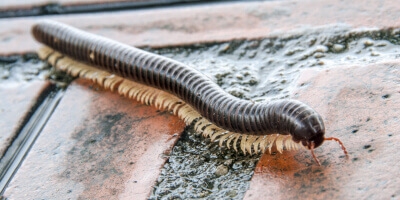Millipede Facts & Information
Everything you need to know about millipedes
WHAT DO millipedes LOOK LIKE

Millipedes can be easily identified by their two pairs of legs per body segment (except for the first three segments that have one pair each). Because of the many legs, they are often called ‘thousand-leggers’. Sometimes they are called ‘wire worms’ because of their cylindrical wire-like body shape. However, they should not be confused with the beetle larvae known as wireworms which have only six legs, feed on grass roots, are typically a dark yellow color and will not crawl about on the soil surface. Most of the millipedes that people come in contact with are a dark brown color, approximately an inch long and one sixteenth of an inch in diameter. Most have a hard outer skin and will curl into a spiral upon death.
Millipedes are decomposers and are beneficial to have around your yard. Similar to earthworms, millipedes eat damp, decaying plant material such as leaves and flowers. During periods of drought, millipedes have been known to feed on living plants where they can get the much needed moisture from the leaves and roots.
Millipedes are decomposers and are beneficial to have around your yard. Similar to earthworms, millipedes eat damp, decaying plant material such as leaves and flowers. During periods of drought, millipedes have been known to feed on living plants where they can get the much needed moisture from the leaves and roots.
Where do millipedes live
Millipedes are many segmented, wormlike arthropods found throughout Pennsylvania, New York, New Jersey, Connecticut, and Delaware. They usually go unnoticed under leaves, rocks, boards, and other locations that provide a cool, damp habitat. Occasionally, millipedes may enter structures in great numbers causing alarm. Fortunately, they do no damage (other than being a nuisance) and cannot long survive the dry atmosphere found within most buildings.
Millipedes normally live in cool, damp places such as under stones, leaf mold, mulch, compost heaps, piles of grass clippings, and brick pathways. At certain times of the year millipedes become restless and migrate from their normal living places. They can appear in window wells, basements, garages, and other places where they become an annoyance. These migrations are often associated with cooler weather or following heavy rains but may also be a function of mating behavior.
Millipedes normally live in cool, damp places such as under stones, leaf mold, mulch, compost heaps, piles of grass clippings, and brick pathways. At certain times of the year millipedes become restless and migrate from their normal living places. They can appear in window wells, basements, garages, and other places where they become an annoyance. These migrations are often associated with cooler weather or following heavy rains but may also be a function of mating behavior.
How did I get millipedes
Piles of compost or grass clippings, leaf mold around shrubbery, and house foundations are likely spots for infestations to continue breeding. Some home foundations have a border of river gravel or other mulching over a blanket of plastic sheeting or similar weed prevention barriers. Millipedes will thrive under these conditions and treatment of the mulching with a pesticide will not be effective, as the pesticide will not penetrate the plastic. Removal of the weed barriers will reduce the soil moisture and increase the temperature – both which are unattractive to millipedes.
what Problems do millipedes cause
Millipedes don’t survive inside for more than a few days. So, if they’re inside your home or business, you can be sure they won’t be there for long unless there’s plenty of moisture. If you do see a lot of millipedes, you should bring in a plumber to check for leaks as well as have professional exclusion work done like sealing cracks and crevices in foundations. But besides looking weird, they don’t cause any problems. Most people bring in an exterminator for millipedes just because they don’t want them there! The pests aren’t welcome in homes and businesses in New York, New Jersey, Connecticut, Delaware, and Pennsylvania. So, the major problem they cause – fear.
How can I prevent millipedes
To prevent future millipede infestations in your home, you should first start by removing their hiding places. Don’t pile mulch against the foundation, and remove leaves, grass clippings, woodpiles, and stones from around the outside of your home. You should also make sure your foundation, basement, and crawl spaces are dry by using dehumidifiers or sump pumps if needed. Keep gutters and downspouts clear of leaves and in good working order to help keep water (and the moisture they love) away from your foundation.
Repair leaky faucets, water pipes, and air conditioning units. Avoid overwatering your lawn and dethatch if needed since millipedes will also live in the thick, moist thatch layer of a poorly maintained lawn. Seal and caulk cracks and other openings in your foundation wall, and apply door sweeps to exterior doors.
Repair leaky faucets, water pipes, and air conditioning units. Avoid overwatering your lawn and dethatch if needed since millipedes will also live in the thick, moist thatch layer of a poorly maintained lawn. Seal and caulk cracks and other openings in your foundation wall, and apply door sweeps to exterior doors.
WHY WESTERN for millipede control
We’re passionate about controlling millipedes in your home or business because we live and work here – it’s our neighborhood, too. With our almost 100 years of experience keeping homes and businesses in Connecticut, Delaware, New Jersey, New York, and Pennsylvania safe from pests, Western has the experience you can trust.
100% Satisfaction Guarantee
24-Hour Guaranteed Response
Board Certified Entomologists
Consider millipedes controlled.
GET MY QUOTE
